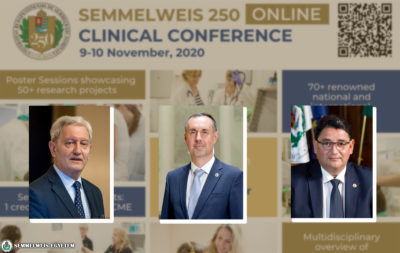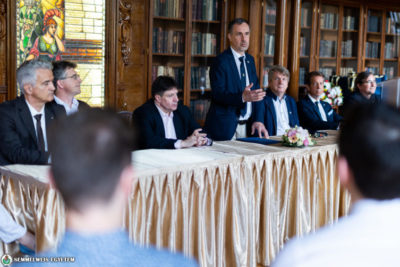The second day of the Semmelweis 250 Clinical Conference was opened by Dr. Attila Szabó, Vice-Rector for Clinical Affairs and the president of the Clinical Center, the event’s organizer, who gave a brief summary of the conference’s first day. He noted that two plenary sessions were held in the morning, one on the challenges posed by COVID-19 and the other concerning cardiovascular medicine, after which poster and parallel sessions were held in the afternoon. He then introduced the day’s first speaker, Dr. Didier Pittet, the director of the Infection Control Programme and World Health Organization (WHO) Collaborating Centre on Patient Safety at the University of Geneva Hospitals and Faculty of Medicine. “His medical odyssey is to promote hand hygiene and patient safety worldwide, and his presentation relates to this topic, focusing on the work of Ignác Semmelweis,” said Dr. Szabó.
 In his presentation titled “Semmelweis: 1818-2020,” Dr. Pittet summarized Semmelweis’s life and work and its significance relating to the world today. He talked about childbed fever, this mysterious illness from the 19th century and its spread, and recalled how Semmelweis discovered the secret to the protection against this disease, the washing of hands, and how this led to a reduction in mortality, while at the same time the challenges and obstacles he faced in the general acceptance of his findings. “We can say that his his work was a data-driven and evidence-based medicine approach, and was actually one of very first randomized control, evidence-based studies, with a long-term,” said Dr. Pittet.
In his presentation titled “Semmelweis: 1818-2020,” Dr. Pittet summarized Semmelweis’s life and work and its significance relating to the world today. He talked about childbed fever, this mysterious illness from the 19th century and its spread, and recalled how Semmelweis discovered the secret to the protection against this disease, the washing of hands, and how this led to a reduction in mortality, while at the same time the challenges and obstacles he faced in the general acceptance of his findings. “We can say that his his work was a data-driven and evidence-based medicine approach, and was actually one of very first randomized control, evidence-based studies, with a long-term,” said Dr. Pittet.
He noted the skepticism Semmelweis faced from his peers and that his discoveries were only accepted and recognized decades after his death. “How would people judge my career?” – Dr. Pittet presented what he would answer this imagined question from Semmelweis, explained that he would tell him how his work and discovery has and will save billions of lives, and how scientists will continue to follow and complete his research and accomplishments. He also noted that if Semmelweis were living today, there is no question that he would be highly recognized and published in high-impact journals.
Following the opening keynote lecture in the morning, participants of the Semmelweis 250 Clinical Conference could choose from several parallel sessions to attend, which covered topics such as transplantation, pulmonology, dentistry, pathology, urology and gynecology, while the event ended with the giving out of poster awards.
Tamás Deme
Photo: Attila Kovács – Semmelweis University (featured image); Robert Koch Stiftung (Dr. Pittet portrait)


